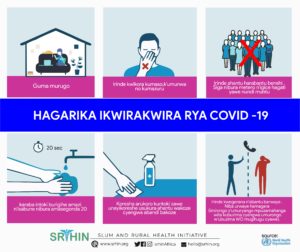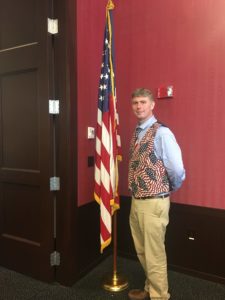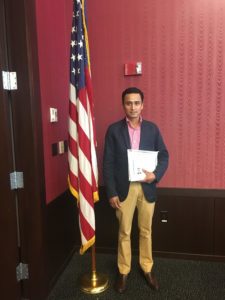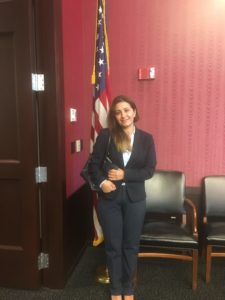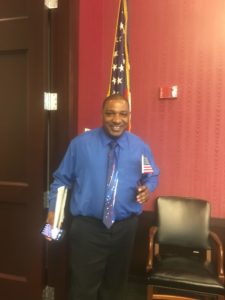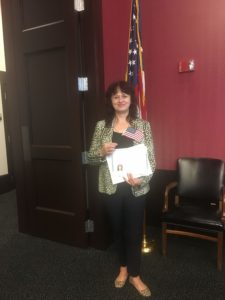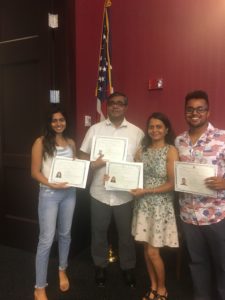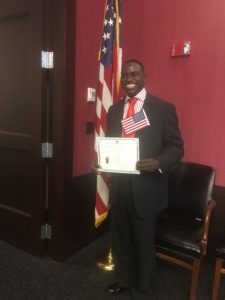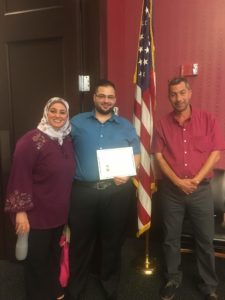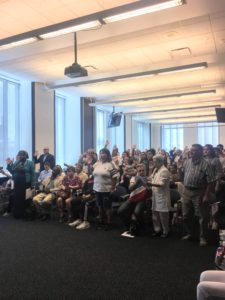IRS Warning about Coronavirus Related Scams
IR-2020-64, April 2, 2020
WASHINGTON — The Internal Revenue Service today urged taxpayers to be on the lookout for a surge of calls and email phishing attempts about the Coronavirus, or COVID-19. These contacts can lead to tax-related fraud and identity theft.
“We urge people to take extra care during this period. The IRS isn’t going to call you asking to verify or provide your financial information so you can get an economic impact payment or your refund faster,” said IRS Commissioner Chuck Rettig. “That also applies to surprise emails that appear to be coming from the IRS. Remember, don’t open them or click on attachments or links. Go to IRS.gov for the most up-to-date information.”
Taxpayers should watch not only for emails but text messages, websites and social media attempts that request money or personal information.
“History has shown that criminals take every opportunity to perpetrate a fraud on unsuspecting victims, especially when a group of people is vulnerable or in a state of need,” said IRS Criminal Investigation Chief Don Fort. “While you are waiting to hear about your economic impact payment, criminals are working hard to trick you into getting their hands on it. The IRS Criminal Investigation Division is working hard to find these scammers and shut them down, but in the meantime, we ask people to remain vigilant.”
Don’t fall prey to Coronavirus tricks; retirees among potential targets
The IRS and its Criminal Investigation Division have seen a wave of new and evolving phishing schemes against taxpayers. In most cases, the IRS will deposit economic impact payments into the direct deposit account taxpayers previously provided on tax returns. Those taxpayers who have previously filed but not provided direct deposit information to the IRS will be able to provide their banking information online to a newly designed secure portal on IRS.gov in mid-April. If the IRS does not have a taxpayer’s direct deposit information, a check will be mailed to the address on file. Taxpayers should not provide their direct deposit or other banking information for others to input on their behalf into the secure portal.
The IRS also reminds retirees who don’t normally have a requirement to file a tax return that no action on their part is needed to receive their $1,200 economic impact payment. Seniors should be especially careful during this period. The IRS reminds retirees – including recipients of Forms SSA-1099 and RRB-1099 − that no one from the agency will be reaching out to them by phone, email, mail or in person asking for any kind of information to complete their economic impact payment, also sometimes referred to as rebates or stimulus payments. The IRS is sending these $1,200 payments automatically to retirees – no additional action or information is needed on their part to receive this.
The IRS reminds taxpayers that scammers may:
- Emphasize the words “Stimulus Check” or “Stimulus Payment.” The official term is economic impact payment.
- Ask the taxpayer to sign over their economic impact payment check to them.
- Ask by phone, email, text or social media for verification of personal and/or banking information saying that the information is needed to receive or speed up their economic impact payment.
- Suggest that they can get a tax refund or economic impact payment faster by working on the taxpayer’s behalf. This scam could be conducted by social media or even in person.
- Mail the taxpayer a bogus check, perhaps in an odd amount, then tell the taxpayer to call a number or verify information online in order to cash it.
Reporting Coronavirus-related or other phishing attempts
Those who receive unsolicited emails, text messages or social media attempts to gather information that appear to be from either the IRS or an organization closely linked to the IRS, such as the Electronic Federal Tax Payment System (EFTPS), should forward it to phishing@irs.gov.
Taxpayers are encouraged not to engage potential scammers online or on the phone. Learn more about reporting suspected scams by going to the Report Phishing and Online Scams page on IRS.gov. Official IRS information about the COVID-19 pandemic and economic impact payments can be found on the Coronavirus Tax Relief page on IRS.gov. The page is updated quickly when new information is available.
Udhëzimet për bizneset mbi CARES Act
- Small Business Administration Economic Injury Disaster Loans
- Asistenca monetare deri në $2,000,000 janë të disponueshme për bizneset.
- 75% norma interesi për bizneset, 2.75% norma interesi për OJF (Organizatat Jo-Fitimprurëse).
- Periudhat janë në varësi të rasteve; deri në periudha 30-vjetore.
- Të përdorshme për të paguar borxhet fikse, listat e pagave, llogaritë e pagueshme.
- SBA EIDL – Programi i GRANTEVE EMERGJENTE
- Subjektet e përshtatshme të cilat kanë aplikuar për një EIDL mund të kërkojnë një paradhënie deri në $10,000.
- SBA do të shpërndajë paradhëniet e emergjencës brënda tre ditëve nga data e kërkimit.
- Paradhënia mund të përdoret ndaj lejeve të paguara shëndetësore, rritje të çmimeve të materialeve, pagesave hipotekare apo të qerave dhe detyrimeve të tjera.
- Nuk ka nevojë të paguhet!
- SBA Express Bridge Loan Pilot
- Kreditorët aktualë SBA kanë aftësinë të përdorin fonde deri në $25,000.
- Fondet mund të pagohen plotësisht apo pjesërisht nga të ardhurat e EIDL.
- SBA 7(a) Programi i Kredive për Mbrojtjen e Rrogave
- Kredi deri në $10,000,000, afërsisht 2.5 herë më e madhe se sa paga mesatare mujore e kompanisë.
- Të ardhurat e kredisë do të mbështesin pagat (duke përfshire përfitimet), sigurimet, si dhe pagesat e hipotekës, qerasë dhe pajisjeve.
- Të pakolateralizuara
- Nuk kanë pagesa kredie për të paktën 6 muaj
- Kreditë janë të vlefshme për t’u falur në bazë të një formule.
- Çertifikimet e kërkuara:
- Kushtet ekonomike të bizneseve të prekura nga COVID-19
- Mosmarrjen e fondeve të tjera nga ndonjë program tjetër SBA.
- Përdorimi i fondeve për të mirëmbajtur punëtorët dhe pagesat.
- Ndihma Ekzistuese Kredituese SBA Për Biznese të Vogla
- E vlefshme për kreditë ekzistuese nën SBA 7(a), 504 dhe mikrokredi
- SBA do të pagojë kryesorin, interesin dhe tarifat për kreditë ekzistuese të mbuluara për një periudhë kohore 6 mujore.
- Kredi të reja SBA nga këto programe (me përjashtim të atyre nën Programin e Mbrojtjes së Pagesave) do të marrin periudhe pagese 6 mujore.
- Shtyrja e taksimeve të pagave
- Bizneset mund të shtyjnë pagesën e taksave FICA të punëdhënësve deri në fund të 2020.
- Pagesat duhet të bëhen në 2021 dhe 2022.
- Shtyrja është e ndaluar për bizneset që përdorin Programin Mbrojtës së Pagave SBA.
- Kredite e taksave për mbajtjen e punëtorëve
- Subjektet e përshtatshme përfshijnë bizneset veprimtaria e të cilave është (1) plotësisht ose pjesërisht të limituara nga urdhërat qeveritarë ose (2) kanë përjetuar një rënie 50% të arkëtimeve bruto që nga 3-mujori i vitit të kaluar.
- Të vlefshëm për kredi takse prej 50% në $10,000 e parë të pagave të paguara ose të caktuara nga 13 Marsi i 2020 deri në 31 Dhjetor 2020.
- Punëdhënësit të cilët marrin kredi të caktuara SBA nuk janë të kualifikuar për të marrë këtë kredi.
合衆国商務省: 中小企業への助成金
合衆国商務省: 中小企業への助成金
4月20日月曜日東部時間午後3時より、合衆国商務省による中小企業助成金が実施されます。
この助成金では、従業員3から20名の企業の事業費に対して5000ドルが支給されます。
助成金の請求は大変需要が高いと思われますので、申し込み期間が始まりましたら早目に手続きされることをおすすめします。
Blessed are the Candle Bearers
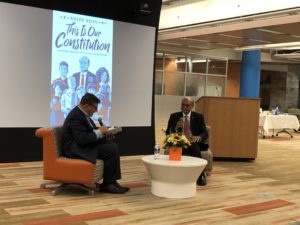 .
.
Everyone has ‘linguistic markers’. Sometimes they mark where you are from geographically, like ‘Baah Haaaabah” for Bostonians. Sometimes they mark what religion you are, like saying ‘mashallah’. Sometimes it’s just your signature word, like Ray Bradbury’s ‘cinnamon’.
Mr. Khizr Khan has three linguistic markers I picked up on during the two days I spent with him at talks in venues around Cleveland: ‘blessed’, ‘uplift’, ‘and candle bearer’. I don’t know what words Mr. Khan uses most often in everyday conversation, but his message featured these at much higher rates than any others.
It’s not surprising that ‘candle bearer’ is a signature phrase, given that he glows with the inner peace of a man doing his God-given work. But it is a challenging and inspiring phrase. Mr. Khan describes the path as dark, and the candle bearers must walk front and center to lead the way. Mr. Khan challenged every single person to harness their light and use their platform for change, be it waking up early to vote, taking someone who cannot drive to the polling station, standing up and saying one person, one vote does matter. Whatever your platform, use it. Mr. Khan reminded us that history shows us one person’s voice can change the world. “Give me liberty or give me death” is a political reality that many around the world contend with, but we in America are not forced to consider it when we send a tweet or state our opinion. Mr. Khan, however, has lived through it, and that is why he is so passionate about our United States’ Constitution.
Mr. Khan recounted how he first fell in love with the US Constitution--yes, in love. That is how deeply Mr. Khan values the words that form this idea of a More Perfect Union. It was during a comparative law class that put constitutions from around the world side by side and compared the merits or each. Nothing compared, in his mind, to the 4,543 words that make up this ‘blessed document’. The fire that was lit inside him eventually took him to America to get not one, but two LL.M. degrees from the University of Missouri Law School and Harvard Law School. It gave him a career in and a passion for law that he spreads as a doctrine of freedom and justice. And like many newcomers to the United States, Mr. Khan is deeply patriotic and grateful to this country. He spoke passionately about the 1st and 14th amendments in each talk he gave.
Pop quiz: how many rights are enshrined in the 1st amendment? How are Plessy v. Ferguson and Brown v. Board related?
You probably cannot answer those questions unless you are in 10th grade civics. And that is just Mr. Khan’s point. We take our freedom of speech for granted. We take for granted the fact that inhumane court decisions can be overturned when our mistakes have been made clear.
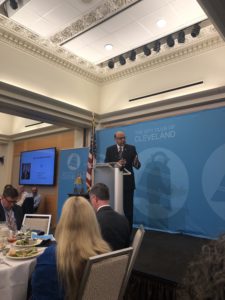
Mr. Khan spoke with the passion of Martin Luther King Jr., but at the level of Mother Teresa. He cried on stage, pausing to ask the crowd forgiveness for losing his composure. He openly acknowledged that each speech he gives tears open the wound left by the death of his middle child, Captain Humayun Khan, who was inspired by the service of President Thomas Jefferson to enroll in the ROTC program at the University of Virginia. Mr. Khan notes that he lives at the bottom of the mountain where Monticello sits, and that it was a total coincidence that he should live in the shadow of the Founding Father’s home and legacy, and that to his home are delivered bags full of letters, some only addressed “Mr. Khizr Khan, United States of America.” This man single-handedly made the United States Constitution the the best selling book in the world on Amazon, which runs out of it regularly since Mr. Khan took to the speaker circuit 3 years ago. This is also a man who was warned to stay inside during the protests in Charlottesville where, as Mr. Khan said, “our daughter, Heather Heyer, was killed”, but he saw firsthand the heavily-armed protesters and heard their ugly chants. People like this man were the aim of their ire, and yet he continues to speak. He continues to bear the light. He continues to uplift the best in us and to defend that which allows the best in us to thrive-- the rule of law, checks and balances, an independent judiciary, and a government by the people, for the people.
I could share many more stories of Mr. Khan’s, but I encourage you to see him when he visits you, or invite him to do so yourself. I will leave you with a story Mr. Khan’s grandfather in Pakistan would share with him after the sun had set, the dinner was eaten, dishes washed, homework completed, and the stars shone in the sky: A thirsty man is blocked from the river by a high wall, so high the man cannot climb it. The man, desperate in his thirst, throws a rock from the wall over it and into the river. The sound of the rock in the water fills the man with joy and hope. The man forgetting his thirst continues to throw rocks into the water. The water asks the man, ‘Why do you throw stones into the water you cannot drink?” The man replies, “Because the beautiful sound of its splashing fills all living things with joy, it is like the sound of the guard’s keys to a prisoner, the sound of rain in the desert, and every stone I throw makes the wall a little lower.” Mr. Khan encouraged us all to be like that man: joyous in our struggle, passionate in the pursuit of our goals, and hungry for the sweet drink of redemption.
“I have seen the sunrise on the other side of the mountain and it is just moments away.”
I would take Mr. Khan at his word. The night is darkest before the dawn, but that is why we are candle bearers.
Immigration, “My Kind of Town,” and a Rose Garden - Ezra Ellenbogen
Immigration, “My Kind of Town,” and a Rose Garden
- Written by Ezra Ellenbogen

Pictured Above is a sign commemorating the sister city relationship between Volzhsky, Shaker Heights, and Cleveland Heights; this relationship was eventually merged with the Volgograd-Cleveland sister city program to form the Greater Cleveland - Volgograd Oblast Alliance
Cleveland has many sister cities, in fact, Cleveland has 23 sister cities.[1] To put that in perspective, Washington DC has 15 sister cities[2], Detroit has 11 sister cities[3], and Boston has 11.[4] In short, we have a lot of sister cities. Despite this, one sister city stands out among Cleveland’s many: Volgograd, Russia. Not only has the sister city relationship flourished, even going on to include Shaker Heights, Cleveland Heights, and Volzhsky (Russia), but the relationship between the cities has helped the Russian culture in Northeast Ohio thrive, making our Russian population[5] feel at home. Recently, the Gagarin Gala helped highlight the numerous Russian cultural contributions to Cleveland as well as celebrating our long-standing partnership with the Volgograd Oblast.
Cleveland and its partnership with Volgograd have made historic strides in the past towards bringing the US and Russia (which was engulfed in the USSR throughout most of the relationship) together. Early immigration to Cleveland included many Russians, and their initial settlement was accompanied by other Eastern European groups (Finns, Poles, etc.).[6] Soon, Cleveland’s Russian immigrants were a major part of the city’s ethnic composition.
Russian cultural influence in Cleveland picked up in the early 1900s, with famous Russian performers like Anna Pavlova coming to visit. Cleveland’s large Russian population meant that the 1917 Revolution had an effect on Cleveland itself. The political disagreements in Cleveland had to do with Russia’s Bolshevik Revolution and rising interest in anarchism. Cleveland’s May Day Riots came at a time of great unrest in the city. This all was caused not only by the disagreement on the political situation back in Russia but also as a result of the First Red Scare and the US’s legal actions taken against many activists. The combination of labor activism and new interests in socialism saw Charles Ruthenberg gain 30% of the mayoral vote in Cleveland. As a result of the May Day riots, Russian immigration to Cleveland increased, and as the events began to blow over, it was clear that the cultural impact of the new Russian population was significant.[7]
Despite the rising tensions between the US and the USSR, culture from Cleveland traveled to Russia and culture from Russia traveled to Cleveland. These exchanges helped ease tensions between the two countries. After the US began to work more with the USSR, two of Cleveland’s leading engineering companies -Arthur G. Mckee & Co. and the Austin Company- contributed to the construction of new Soviet projects, namely the creation of a new industrial city (Magnitogorsk) and an idealist worker’s paradise (Avtozavod), accompanied by the construction of a large automobile factory. This collaboration between the US and the USSR helped encourage their later partnership in World War II and helped to delay Cold War tensions. However, during the Cold War, Cleveland gained minor missile bases.[8]
As the Soviet Union expanded into Eastern Europe, refugees fled worldwide, and many of them came to Cleveland. The most notable group were the Hungarians, who contributed to Cleveland’s culture greatly. As worry increased about the Cold War, people in Cleveland began to call for an easing of relations. Cleveland capitalists began to influence the USSR, helping to influence Krushchev towards cooperation with the US. Krushchev and his advisors gave a gift (specifically, a troika - a Russian sleigh pulled by three horses) of appreciation to Cyrus Eaton, the Cleveland activist who helped spur the movements to cooperate with the USSR. A famous moment occurred when Anastas Mikoyan, Krushchev’s top advisor, became emotional at the sight of Cleveland’s Terminal Tower when he was visiting the city and stated: “Now you’re talking! This is my kind of town!” Cleveland culture was brought to places all throughout the USSR, mostly through the Cleveland Orchestra’s Eisenhower-approved concerts. The Soviet Union returned the favor by offering the rights to a reportedly outstanding opera, which was performed by the Cleveland Orchestra in Severance Hall in 1935.
In 1985, Cleveland established a sister city partnership with Volgograd, Russia as a result of the cultural contributions of the Russian population in the area had already made and the many collaborations between Russia and Cleveland.[9] Then, a wondrous architectural feat was accomplished, namely: Tremont’s St. Theodosius Russian Orthodox Cathedral. This cathedral is an architectural masterpiece and is one of the best representations of Russian cultural contributions to major cities in the United States. The new structure highlighted the capabilities of the Russian population in Cleveland and helped move the sister city relationship forward.
Then, as Shaker Heights and Cleveland Heights began to worry about the Cold War and what effects it could have if it was not de-escalated, they signed an agreement with Volzhsky, Russia as sister cities in 1988 (both suburbs were sister cities to Volzhsky). A sign and rose garden were placed at the East end of Horseshoe Lake in Shaker Heights to celebrate the momentous development in Cleveland’s history of cooperating with Russia and helping the US do the same, specifically the involvement between Shaker Heights, Cleveland Heights, and Volzhsky. The sign and the rose garden are living legacies of this historic sister city relationship. The sign and the garden still stand today right next to the very popular Horseshoe Park - (the “Sister Cities” Rose Garden is pictured at the top of the article).
Ten years later, Cleveland’s partnership with Volgograd, Shaker Heights’ partnership with Volzhsky, and Cleveland Heights’ partnership with Volzhsky were combined to form the Greater Cleveland Volgograd Oblast Alliance (GCVOA).
The GCVOA provided much more than just a sister city relationship. The GCVOA established not only humanitarian aid, professional training, and mutual infrastructure help as services for Volgograd and Volzhsky, but also a Free Speech Forum for the Russian population. The Volgograd-based Free Speech Forum in Russia was patterned after the City Club of Cleveland. Medical help and aid were provided to the region in Russia, mostly through instruction and some visits. Cultural exchange was also important to the program.[10]
This year has seen many great developments in the sister city relationship. From May 1-3rd, Global Cleveland hosted their Inaugural Sister Cities Conference, with the largest delegation there coming from Volgograd. The GCVOA has made plans to re-engage the relationship between Greater Cleveland and the Volgograd area, including free speech discussions and a delegation from Cleveland visiting Volgograd.
On May 3rd, 2019, the city of Cleveland, in cooperation with the Russian population, held the first Russian Community Day. Not only did this celebration help highlight Russian culture thrive once again, but it will also be an annual endeavour. Russian music, ballet, and food was celebrated in Cleveland City Hall. The event did an amazing job of embracing the GCVOA’s goals as well as creating a demonstration of the thriving Russian cultural presence in Cleveland. Mayor Frank Jackson’s idea for “Russian Community Day” will continue on as a legacy for Cleveland’s culture.
And most recently, the Gagarin Gala was hosted by the Russian Cultural Garden group at Great Lakes Science Center, in celebration of a new Yuri Gagarin sculpture in the Russian Cultural Garden and historical contributions made by Cleveland’s Russian population. Pietro Shakarian spoke about the history of Cleveland’s Russian population and brought attention to the many achievements of Cleveland’s partnerships with Russia over the years. Events like this bring Cleveland together, letting our many ethnic groups flourish. The sister city program and its ambitions will allow for Cleveland’s Russian population to feel at home. This historic sister city relationship will continue to have major political and cultural implications in the future and will help Cleveland and its Russian population thrive.
The Russian population of Cleveland has contributed immensely to the local culture and our sister city relationship that came as a result of this helped to provide real political dialogue between the US and the USSR. Events like this show how immigration can shape the world.
Blog: Ezra's blog
[1] https://www.clevelandfoundation.org/2019/05/inaugural-sister-cities-conference-welcomes-23-international-communities-to-cleveland/
[2] https://os.dc.gov/service/dc-sister-cities
[3] http://en.sistercity.info/sister-cities/Detroit.html
[4] https://www.boston.gov/economic-development/sister-cities
[5] http://worldpopulationreview.com/us-cities/cleveland-population/
[6] https://case.edu/ech/articles/cleveland-russian-relations
[7] https://case.edu/ech/articles/m/may-day-riots
[8] https://case.edu/ech/articles/n/nike-missile-bases
[9] Gagarin Gala Event Handout
[10] http://www.oocities.org/gcvoa/projects.htm
Naturalization Ceremony August 16th, 2019
Welcome to America!
This is what an American looks like.
Families, students, professionals, dreamers, workers.
There is nothing like watching humanity join together is swearing their allegiance to this beautiful, messy, country.
Global Cleveland offers every single new American a welcoming packet full of information about resources in our area that we hope makes them see how much we value them and their incredible efforts along this journey.
Next time you have a Friday free, come join us at the Stokes Federal Court House for a morning you will not soon forget.
From war zones and wealth, Caribbean Islands, and frozen tundras, here in Cleveland we have people from every walk of life choosing to make this their home.
God Bless America and each person that helped our newest citizens on their path to citizenship.
Talking Points for Public Charge Changes
PUBLIC CHARGE
The proposed rule change so broadens the definition of “Public Charge” as to include millions of people who are already contributing members of society and the economy. It implicitly and incorrectly assumes that people who receive benefits now cannot become productive contributors in the future.
Most immigrants are not eligible for public benefits until they have had been in the US for 5 years. So, if at any point they need assistance, they will now need to choose to receive public benefits or have the chance to apply to be a legal permanent resident and eventually a citizen-where one has full rights to apply for and use public benefits. For many immigrants, education and income guidelines will affect their ability to get a visa possibly more than the use of public benefits themselves.
Instead of keeping the current definition of a “public charge” as someone “primarily dependent on the government for subsistence,” DHS would start denying green cards and temporary visas to anyone who is deemed likely at any time in the future to receive any government benefits from a specified list.
Under current rules, you are not considered “likely to become a public charge” as long as you have a sponsor who demonstrates income greater than 125% of the federal poverty guidelines (currently $20,575 for most couples without children. Congress requires most green card applicants to have a financial sponsor – typically a family member who is a U.S. citizen – who declares their willingness and ability to support their relative and prevent them from becoming dependent on government benefits.
This will change with the new standards. Now there will essentially be a wealth test imposed on new immigrants.
The only way to ensure not being affected by the new criteria would be to demonstrate a household income above 250% of the federal poverty guidelines. That’s currently $41,150 for a couple with no children and $73,550 for a family of five.
The Migration Policy Institute used Census data to estimate the impact of the 250% income threshold and found that some 56% of all family-based green card applicants could be denied.
If this new requirement were strictly enforced by both DHS and the State Department, then the administration could begin denying more than half of all marriage green card applicants each year. That could force nearly 200,000 couples annually to either leave the United States together or live apart indefinitely, according to a new report by Boundless.
40% of all green cards issued are for family reunification, but if those family members are poor, older, or less educated their visa will be denied. Grandparents, young children, and non-working spouses contribute in significant ways to our society even if they do not meet this wealth test.
The new standards will scare people off from applying for benefits-even people who qualify for them. This is known as a chilling effect, and there is good evidence to show this will happen in the current situation:
In 1996 a welfare reform law was passed. Food stamp use by noncitizens dropped by 43%. Refugee use of food stamps fell by 60% EVEN THOUGH THEY WERE ELIGIBLE AND NOT ADVERSELY AFFECTED. Families with at least one U.S. Citizen child legally entitled to benefits fell 53%. The perception alone of a negative consequence to their immigration status was enough to scare them away from using benefits to which they were entitled.
An estimated 24 million people in the United States would be affected by the chilling effect of the public charge regulation changes. Not all will face a public charge determination, but all are likely to be nervous about applying for benefits, and some portion will in fact disenroll from benefit programs.
In Cleveland, only 13.3% of eligible immigrants are naturalizing. Anyone thinking of applying for a green card will lose that opportunity if they use public benefits or do not earn sufficient income. Naturalized immigrants earn more than unnaturalized immigrants, yet these changes hamstring their opportunity to take care of themselves and their families during the interim.
Yet Ohio’s immigrants pay into the U.S. entitlement programs they many cannot now use- to the tune of $412.1M to Medicare and $1.5B to Social Security, according to the New American Economy. They also contribute $2.1B in taxes, with no right to use the system.
The Greater Cleveland Food Bank served 55.3 million meals in 2017
- Over 4500 children, 10,450 seniors, and 4,600 low-income clients with health problems served.
- Assisted with over 22,000 SNAP applications submissions
- Made over 17.5 million meals available through SNAP
If immigrants are not eligible or afraid to use SNAP benefits it puts further stress on existing resources.
Immigrants help stabilize our population. In Ohio, there were 150,000 estimated lawful permanent residents in 2014, according to DHS. 737 refugees settled in Cleveland that same year and nearly 1,100 refugees resettled in Cleveland in 2016, according to the Refugee Service Collaborative. Many of these immigrants fill important jobs, bring new ideas to our community, and are more educated than the native-born population.
A 2018 report on Ohio’s New Americans found that 42.1% of Ohio’s immigrants have a 4-year degree or higher, according to the latest figures from the Census. That ranks Ohio as the most educated state in the nation for immigrants, tied with Maryland. Ohio’s 513,5929 immigrants have an oversized impact in ensuring that Ohio is globally connected.
By comparison, only 26.7% of native-born Ohioans are college-educated. That difference in college educational attainment between Ohio’s immigrants (42.1%) and their native-born counterparts (26.7%) is 15.4 percentage points: the largest divide in the nation.
Immigrants work in growing fields and fill employment gaps. The New American Economy found that the top Industries with Highest Share of Foreign-Born Workers are:
9.1% Professional, Scientific, and Technical Services
7.7% Educational Services
7.6% Manufacturing
7.2% Health Care and Social Assistance
7.1% Transportation and Warehousing
Ohio’s immigrants primarily work in the Management, Business, Healthcare, and the Arts—a diverse professional services sector that includes industries such as education, hospitals, and other health facilities, and computer systems and legal services. Specifically, 43.6% of Ohio’s immigrants in the labor force work in the professional services sector: the second-highest concentration in the nation. Over seventeen percent (17.3%) work in Production and Transportation, ranking in the top 20 nationally. If these workers come upon hard times and cannot apply for benefits to support themselves and their families, will they quit? What kind of labor shortage will this cause? What kind of strain on the economy will workers who are not well fed and have medical care create?
About 20% of Ohio’s college-educated immigrants are underemployed—the fiscal effects are significant, with half a billion lost in foregone earnings and an associated $53 million in unrealized payroll tax receipts, according to the Migration Policy Institute. Public benefits can help support these immigrants while they work to obtain stronger language skills or acclimate appropriately to enter the workforce. It is important to support our immigrants so they can be as successful as they can and achieve their American Dream.
The New American Economy found that NEARLY 44% OF AMERICAN’S FORTUNE 500 COMPANIES WERE FOUNDED BY AN IMMIGRANT OR CHILD OF AN IMMIGRANT, and the children of these immigrants, who generation after generation have found even more success than their parents, have played a central role in shaping America’s economy. Immigrants pay into public benefits anyway, pay taxes anyway, and then go on to entrepreneurs. The least we can do is offer them support when they need it without tying their “self-sufficiency” to a green card.
The Fiscal Policy Institute found that immigrants applying for green cards based on family status or employment would be primarily affected. These types of immigrants are the ones who create stable home environments for the most growth and wellbeing of their communities, hence severely handicapping the economic security of those families as well as local economic growth.
Having an income of under $15,000 for a single person or $31,000 for a family of four would be weighed negatively, and could lead to a denial. Thus, coming from country with lower standards of living makes it practically impossible to pass the public charge test-codifying the racist, xenophobic rhetoric used by the President regarding which immigrants are worthy to be in the United States.
6.9 million children who are eligible for public benefits may not receive them because their parents are afraid to apply because of the parents’ status, thus weakening families and denying children the right to grow up healthy.
NEO has the densest population of foreign-born residents in the state of Ohio. The immigrant population in the state at large is 4.3%, in Cleveland it is 5.2% but owner-occupied housing in Cleveland is 41.8% vs state rate of 66.1% makes denying immigrants use of public housing even more problematic.
13% of immigrants in Cleveland speak another language than English vs 6.9% statewide. Public charge changes would significantly affect Clevelanders at a disproportionate rate.
Median household income in Cleveland is $27,800 vs $52,400 statewide. Public charge changes would have a negative compounding effect because immigrants in poverty would not have any social safety net.
Ohio's population lost about 183,000 native-born Ohioans over the past six years. But over that same period, nearly 113,000 immigrants moved into the state, "helping stabilize Ohio's population, and are, in fact, a source of growth." (https://engagedscholarship.csuohio.edu/cgi/viewcontent.cgi?article=2526&context=urban_facpub)
42.1% of Ohio’s immigrants have a four-year degree.
43.6% of Ohio’s immigrants work in the professional sector.
62.2% of Ohio’s immigrants are married with children.
(https://engagedscholarship.csuohio.edu/cgi/viewcontent.cgi?article=2526&context=urban_facpub)
Cuyahoga: 47.6% Native, married-couple family; 65.5% foreign-born, married couple family
Divorce rate: 9% vs 14% Foreign-born vs. Native-born
(Source: ACS 5-Year 2015 Percent of Married Family Households.)
Immigrants in Ohio are well educated but may not come with enough income to be awarded visas, change of status, or green cards, but that doesn’t mean they are a drain on our economy, they in fact help it by stabilizing the population and workforce.
It’s not just high-skilled immigrants Ohio needs, but low-skilled immigrants as well. In fact, many of America’s fastest-growing occupations require no secondary education at all, including construction and leisure and hospitality. Here, 18.1% of Ohio’s immigrants work in the service sector—including janitorial, housekeeping, and the food and beverage industry—while 6.5% work in construction and maintenance. The lower-skilled occupation that’s in most demand, however, is in personal care and home health, with an additional 1.1 million care providers needed by 2024. Yet the supply of workers is increasingly unmet.
“TEN YEARS FROM NOW, THERE ARE GOING TO BE LOTS OF OLDER PEOPLE WITH RELATIVELY FEW LOW-SKILLED WORKERS TO CHANGE THEIR BEDPANS,” SAYS DAVID CARD, PROFESSOR OF ECONOMICS AT UNIVERSITY OF CALIFORNIA, BERKELEY.
“THAT IS GOING TO BE A HUGE PROBLEM,” BECAUSE OHIO’S POPULATION BULGE FOR NATIVE BORN RESIDENTS IS FROM AGESS 50-65, WITH FEW WORKING AGE ADULTS, BUT THE BULK OF FOREIGN-BORN RESIDENTS ARE AGED 25- 44 YEARS.
(https://www.olaf.org/wp-content/uploads/2018/03/Ohio-Immigrants-Report-FINAL-1.pdf)
Foreign-born workers play an increasingly important role in the stabilization of our economy and labor market as badly needed labor as baby boomers retire the growing labor force gap grows. Immigrants and their U.S. born children will mitigate this growing labor gap over the next several decades.
Home health aides, for instance, earn an average $10 per hour. To that end, there’s substantial evidence that shows immigrants fill the nation’s most demanding jobs in large part because native-born Americans won’t. (https://www.nytimes.com/2017/08/08/business/economy/immigrants-skills-economy-jobs.html)
23.3% of employed foreign-born persons 16 years and older work in service occupations-health care support, food preparation, building and grounds cleaning and maintenance, personal care and service.
It is often cited that immigrants take jobs and reduce wages. In fact, foreign-born workers add jobs by increasing consumer demand and they specialize in jobs that enhance demand for native-born workers by making the latter more productive (Cato Journal, Vol. 37, No. 3).
How many mothers, with the support of a foreign-born nanny, go back to work after having children? Or how many middle professionals can employ a foreign-born home health aide to help with their ailing parent and not have to take extended leaves from work? But it is precisely these immigrants that the proposed public charge changes effect because these kinds of jobs tend to not pay living wages, which precipitate the need for public assistance, which can get this caretaker deported if the proposed changes go into effect.
A total of 8.3 million children who are currently enrolled in Medicaid and CHIP or receiving SNAP benefits are potentially at risk of disenrollment, of whom:
5.5 million have specific medical needs:
615, 842 children with asthma,
53,728 children with epilepsy,
3,658 children with cancer, and
583,700 children with disabilities or functional limitations.
Nearly 2 million children are at risk of being disenrolled from these programs as parents choose between applying for a green card or receiving Food Stamps and Medicaid for their children. (JAMA Pediatrics. Published online July 1, 2019. doi:10.1001/jamapediatrics.2019.1744)
Some children will themselves be subject to the Trump Rule. A far greater number live in families that will likely experience a chilling effect. In the United States, 9 million children under 18 years old live in families with at least one non-citizen family member and that have received one of the benefits specified by the Trump Rule. The large majority, 7.8 million of the 9 million, are United States citizens with a right to those benefits.
Legal immigrants use federal public benefit programs at lower rates than U.S.-born citizen
32.5% of native-born citizen adults receive SNAP benefits
25.4% of naturalized citizen adults receive SNAP benefits
29% of noncitizen adults receive SNAP benefits
In addition to immigrants’ lower rate of SNAP usage, they also receive lower benefit values, costing the program less, according to the National Immigration Forum.
29% of people born in the United States would be deemed unacceptable if they were subjected to the same test. (http://fiscalpolicy.org/wp-content/uploads/2018/10/US-Impact-of-Public-Charge.pdf)
The USDA calculates that every dollar in new SNAP benefits results in $1.80 in total economic activity in Ohio. There are over 37,000 households receiving SNAP benefits in Ohio.
3.5% are Latino/Hispanic households
38.4 are white households
50.3% of households have children under the age of 18
Over 60 million dollars a year are awarded in SNAP benefits, that generates more than 108 million dollars in economic activity produced.
Boston Medical Center’s Children’s HealthWatch’s study in 2018 surveying over 35,000 immigrant families have found that SNAP enrollment has dropped 10% in the first half of 2018, showing that the chilling effect started before these standards were even put in place.
The Center on Budget and Policy Priorities and the Economic Policy Institute ran a simulation just regarding the use of the two most popular public subsidies: SNAP and Medicaid. The economic impact of potential disenrollment is HUGE.
Simulated Impact of Trump Rule
| 15% Disenrollment in SNAP and Medicaid | 25% Disenrollment in SNAP and Medicaid | 35% Disenrollment in SNAP and Medicaid | |
| Reduction in Benefits | $7.5 billion | $12.5 billion | $17.5 billion |
| Potential Economic Ripple Effects | $14.5 billion | $24.1 billion | $33.8 billion |
| Potential Jobs Lost | 99,000 | 164,000 | 230,000 |
If money on this scale is withdrawn from the economy, there would be predictable ripple effects to businesses and workers. Withdrawal of SNAP funding means a reduction in spending in grocery stores and supermarkets. When families lose health insurance, hospitals and doctors lose income. Other spending would be reduced as well, as families struggle to pay food and health costs.
SNAP and Medicaid, along with other public benefits serve as an important economic stabilizer: they create a bigger stimulus during an economic downturn and less in a period of high growth, according to the Fiscal Policy Institute.
The chilling effect will hurt workforce development. As our nation continues its efforts to build a skilled workforce it is contending with record low unemployment. Businesses are struggling to fill open positions, particularly for middle-skill jobs.
Immigrants account for one in six U.S. workers. They are essential to closing this skill gap. The proposed rule would undercut immigrants’ ability to access training for middle-skill jobs. Even though the public charge proposal does not apply to some categories of immigrants (such as refugees), does not include education and workforce programs, people are nevertheless expected to withdraw from a wide array of public programs out of fear and confusion.
Thus: the chilling effect goes far beyond the scope of the rule itself. Immigrant participation in publicly funded adult education and workforce programs is expected to decline, which we see happening already with food and medical subsidies.
When basic needs cannot be met, dropout rates for training programs increases and fewer students enroll in education and training programs. Adult learners and jobseekers will have to decide between dis-enrolling from health and nutrition programs and jeopardize their ability to complete their training or to stay enrolled in the programs and potentially jeopardize their immigration status. Without being able to use public benefits such as SNAP and Medicaid to take care of basic needs, how will immigrants ever get past the economic hurdle to becoming economically self-sufficient?
Under the proposed regulation, one could be barred for having a child with a chronic illness, a home mortgage, a past dispute that has impacted one’s credit score, or an annual income under $63,000 a year (above the median household income for U.S.-born families), to name just a few of the numerous potentially disqualifying factors.
As a result, many immigrants who are working full time, supporting a family, and contributing to the economy could be barred admission or denied permanent residency. Legal status could be denied even to immigrants who are up to 95 percent self-sufficient, according to the CATO Institute.
Regarding Employers:
A U.S. employer is going to find it more difficult and much less predictable to extend the status of a highly skilled worker on an H-1B visa or to help switch a key recruit from a student visa to an H-1B.
Unless the employer is paying the worker more than that newly made-up threshold – 250% of the poverty line – they might not be able to renew their work visa and stay in the United States. Assuming $73,550 for a family of five, that’s potentially going to be some portion of H-1B professionals.
According to DHS the new public charge rule would affect over 500,000 temporary visa applications each year and compliance costs could top $1.3 billion over the next decade, which doesn’t include if the State Department starts applying the same standards to millions of applicants abroad.
Applicants’ approval process will become even longer, which is a burden on employers due to a new “Declaration of Self-Sufficiency form and the accompanying evidence.
Summary:
Any of the following factors could become a “negative factor” that convinces DHS you are likely to become a public charge:
- Prior or current use of certain public benefits.
- Being older than 61.
- Being younger than 18.
- Having any medical condition that could interfere with school or work.
- Not having sufficient resources to cover such a medical condition.
- Not having private health insurance.
- Having several children or other dependents.
- Having financial liabilities.
- Having “bad credit” or a low credit score.
- Having no employment history.
- Not having a high school diploma or higher education.
- Not having “adequate education and skills” to hold a job.
- Not speaking English.
- Receiving an application fee waiver from DHS.
- Having a sworn financial sponsor whom DHS feels is “unlikely” to follow through.
These factors in any combination mean only wealthy, educated, working-age people are deemed worthy enough to reside in the United States and maybe eventually become United States Citizens
When you have to choose between getting a green card and taking your child to the doctor or letting them go hungry, there is a problem, and it is not that immigrants are depleting public resources. The public charge changes deny humans the chance to contribute economically and socially, and by default will cost our taxpayers billions, our employers great workers, and our dignity as a nation of immigrants.
* * *
Compiled by Elizabeth Cusma for Global Cleveland, July 2019
 Updates & Resources available in Multiple Translations
Updates & Resources available in Multiple Translations 



